
In a digital era where businesses strive to stand out in a sea of online offerings, the evolution of advertising strategies has taken a localized turn with Local Services Ads (LSAs). From their inception to their transformation into an integral aspect of modern business growth, LSAs have reshaped the way businesses engage with customers in their immediate vicinity.
Marko Sipila, the owner of Own Your Own Marketing, unravels the intricacies of LSAs, equipping you with the knowledge and insights needed to harness their potential for success. Spanning a spectrum of topics, we will delve into the historical roots of LSAs, understanding their evolution from concept to industry game-changer. We’ll explore the multifaceted benefits that LSAs offer, presenting a compelling case for businesses seeking to establish a local market stronghold.
The History of Local Service Ads (LSA)

The history of Local Services Ads (LSAs) is a testament to their transformative impact on online advertising and local service provision. LSAs have evolved significantly from their inception to becoming a cornerstone of modern digital marketing.
LSAs emerged due to the growing need for local businesses to establish a strong online presence. Traditional text-based ads struggled to provide reliable information about local service providers, leading Google to explore tailored advertising formats. In 2015, the precursor to LSAs, the Home Service Ads program, was launched, connecting users with local service professionals and introducing the “Google Guaranteed” badge.
In 2017, Local Services Ads officially debuted, extending beyond home services to various industries. The introduction of the Google Guaranteed badge and ongoing enhancements, such as expanded service categories and mobile compatibility, solidified LSAs as a trusted and effective tool for businesses to connect with local customers. Today, LSAs stand as a vital component of local marketing strategies, reflecting Google’s commitment to providing accurate and efficient connections to local service providers in an ever-evolving digital landscape.
How Local Service Ads Are Different
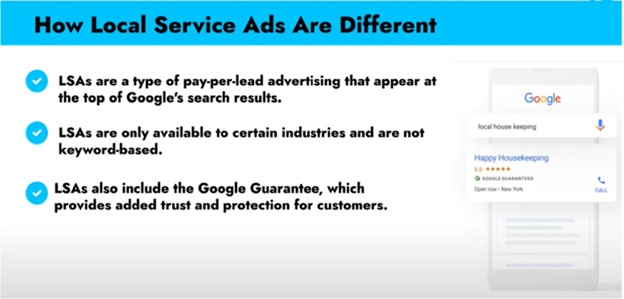
In the realm of online advertising, Google’s Local Services Ads (LSAs) stand out as a game-changer compared to traditional online ads. These distinctions highlight why LSAs are transforming the landscape of local advertising.
1. Targeting Local Audiences: LSAs focus on localization, connecting businesses with nearby customers actively seeking services. This not only enhances user experience but also delivers high-quality leads.
2. Cost-Efficiency and Accountability: LSAs use a pay-per-lead model, unlike traditional pay-per-click ads. Businesses only pay when a lead is generated, optimizing budget allocation for tangible outcomes.
3. Trust and Credibility: LSAs feature the Google Guaranteed badge, symbolizing trustworthiness through a rigorous screening process. Traditional online ads lack this standardized marker of credibility.
These differences set the stage for understanding LSAs’ unique advantages in subsequent chapters, where we’ll delve deeper into Google Guaranteed, the impact of reviews, LSAs’ appearance on Google SERPs, and the mechanics of creating and optimizing LSAs for local market success.
The Role of Google Guarantee
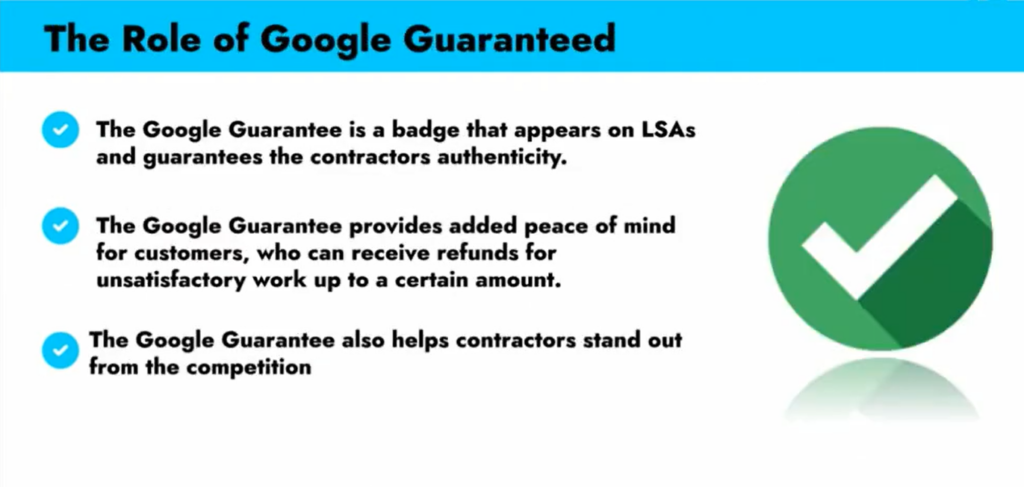
Google has introduced the Google Guaranteed program as a central component of Local Services Ads (LSAs) to establish confidence in both businesses and customers.
1. The Google Guaranteed Badge: This distinctive green checkmark badge appears beside qualified businesses in LSAs, signifying Google’s verification of the business’s authenticity and legitimacy. It instills trust in potential customers, setting Google Guaranteed businesses apart.
2. Elevating Quality Standards: Earning the Google Guaranteed badge entails a thorough screening process, including background checks, license verification, and insurance checks. This rigorous screening ensures that businesses meet high-quality standards and eliminates those with questionable intentions.
3. A Commitment to Service Excellence: By achieving the badge, businesses not only convey trustworthiness but also commit to maintaining a high standard of service excellence, aligning with Google’s policies. This chapter delves into strategies for businesses to navigate the qualification process, showcase the badge effectively, and capitalize on its impact on potential customers.
The Impact of Reviews on LSA
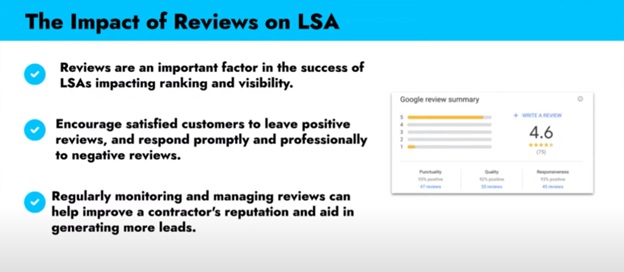
Within the context of Local Services Ads (LSAs), the impact of reviews is amplified, contributing to enhanced visibility, credibility, and conversions. This chapter delves into the pivotal role of reviews in LSAs and offers strategies for effectively managing and leveraging them for advantage.
1. The Significance of Customer Reviews: Customer reviews act as bridges between businesses and potential customers, providing valuable insights into service quality. In LSAs, where trust and attracting high-quality leads are paramount, positive reviews serve as guiding beacons, directing potential customers towards businesses that have demonstrated their worth through real-world experiences.
2. The Impact on Ad Placement and Visibility: Reviews significantly influence the placement and visibility of LSAs. Positive reviews are rewarded by Google with higher placements in search results, increasing the likelihood of clicks and conversions. Businesses boasting a strong track record of positive reviews enjoy a competitive edge, capturing the attention of users who are more likely to trust and engage with highly rated service providers.
3. Building Credibility and Trust: Positive reviews act as powerful antidotes in a landscape where skepticism prevails. They build credibility by showcasing that real customers have enjoyed positive experiences with a business. The accumulation of positive reviews fosters trust among potential customers evaluating their options. Additionally, strategies for responding to reviews, encouraging more of them, and showcasing them in LSAs are explored in this chapter.
Placement of Local Service Ads on the Google Page
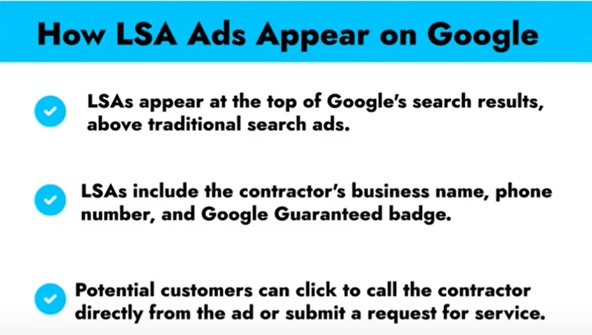
The ever-evolving digital landscape has spurred Google’s commitment to delivering relevant and valuable search results, giving rise to Local Services Ads (LSAs). These ads are strategically designed to seamlessly align with user intent, presenting a golden opportunity for local businesses to connect with potential customers. This chapter explores the appearance of LSAs on Google’s Search Engine Results Pages (SERPs) and the myriad benefits they bring to both local businesses and consumers.
1. The Visual Distinctiveness of LSAs: When users search for local services on Google, LSAs catch their eye with a distinctive format. Typically situated at the top of search results, LSAs feature the business name, Google Guaranteed badge, average review rating, and a brief service description. This visual prominence immediately captures users’ attention, setting LSAs apart from other search results.
2. Enhanced Visibility for Local Businesses: LSAs present a unique opportunity for local businesses to leapfrog their competition and engage users searching for relevant services. Prime placement ensures that businesses with Google Guaranteed badges and positive reviews are portrayed as trustworthy options, boosting their chances of selection.
3. Efficient Customer Decision-Making: LSAs simplify customer decision-making by offering vital information at a glance. Users can swiftly assess a business’s average rating, available services, and proximity to their location. This streamlined presentation expedites the user’s journey from search to decision, benefiting both customers and businesses.
How Does the Billing Work
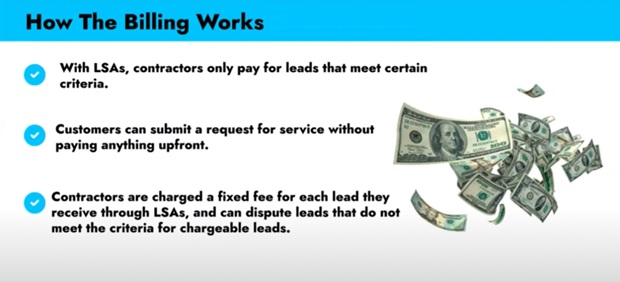
Effective advertising isn’t just about visibility; it’s about achieving cost-effective results. Local Services Ads (LSAs) introduce a pay-per-lead model that aligns with businesses’ goals of acquiring high-quality customers. In this chapter, we’ll explore LSA billing, revealing how businesses are charged and how this transparent approach benefits both businesses and customers.
- Pay-Per-Lead Model: Unlike traditional pay-per-click (PPC) advertising, LSAs charge businesses only when they receive a valid lead, such as a customer inquiry. This shift from clicks to conversions ensures businesses get value for their investment.
- Defining Valid Leads: Google sets criteria for what qualifies as a valid lead, ensuring fairness and quality. This approach charges businesses only for leads likely to convert, enhancing interactions.
- Budget Control: Setting up an LSA campaign empowers businesses to manage costs effectively. They can specify their weekly budget, preventing overspending and enabling better financial control.
- Bid Management and Competitiveness: Google’s algorithm considers bid amount and responsiveness to customer inquiries. Quick and consistent responders gain better ad placement, enhancing competitiveness.
- Transparent Tracking: Google provides transparent tracking tools for monitoring ad performance and leads generated. This empowers businesses to evaluate campaign effectiveness and make informed decisions.
- Cost-Effective Results: LSAs’ pay-per-lead model maximizes return on investment by charging for opportunities to convert leads into customers.
- Reducing Wasted Spend: LSAs eliminate charges for irrelevant clicks, optimizing budget allocation and improving the user experience.
- Accessible Advertising: LSAs make advertising accessible to businesses of all sizes, ensuring investment is linked to customer acquisition potential.
- Building Trust: LSA billing fosters trust by charging only for valid leads, demonstrating Google’s commitment to a fair and transparent advertising environment.
In upcoming chapters, we’ll delve into campaign performance measurement, lead response strategies, and LSA optimization practices for maximum impact.
The Importance of Responding Promptly to Leads
Responding promptly to leads generated through Local Service Ads (LSA) is crucial for several reasons.
First, when a potential customer submits a request for service through LSA, they are actively seeking assistance and are likely to be in a decision-making mindset. By responding quickly, you capitalize on their immediate interest and increase the chances of securing their business.
Second, in the digital age, consumers have come to expect quick responses and instant gratification. If you fail to respond promptly, they may move on to another service provider who does. Prompt responses demonstrate your professionalism, reliability, and dedication to customer service, which can set you apart from the competition.
Furthermore, Google takes responsiveness into account when determining ad ranking and visibility. Ideally, the response should be within 15-30 minutes of receiving them. The more responsive you are to leads, your ad will likely be prioritized and displayed prominently to potential customers. This can significantly impact your visibility and the number of leads you receive.
Lastly, responding promptly establishes a positive first impression and builds trust with potential customers. It shows that you value their time and are committed to addressing their needs. This positive interaction increases the likelihood of conversion and customer satisfaction.
The Benefits of Local Service Ads
Local Services Ads (LSAs) are a game-changer for businesses in their pursuit of local market dominance. They offer an array of advantages that streamline advertising efforts and drive growth.
1. Cost-Effective Investment: LSAs adopt a pay-per-lead model, ensuring businesses only pay when connecting with potential customers. This cost-effective approach optimizes budget allocation, delivering a higher return on investment (ROI). Businesses can allocate resources more efficiently, focusing on leads likely to convert.
2. Enhanced Credibility and Visibility: LSAs grant businesses a Google Guaranteed badge, signaling trustworthiness and credibility. This badge boosts conversions and enhances visibility in competitive local markets. The visual appeal and trusted status of LSAs set them apart, positioning businesses as reliable service providers.
3. Streamlined Customer Acquisition: LSAs simplify the customer acquisition process with their visually appealing format, clear information, and instant connection options. Potential customers can engage effortlessly, leading to quicker conversions. This aligns with modern consumer expectations and encourages immediate interactions.
LSAs offer cost-effective advertising, credibility, and streamlined customer acquisition. They level the playing field for businesses of all sizes, providing a competitive edge in the quest for local market dominance.
Best Practices for LSA
To harness the full potential of Local Service Ads (LSAs) and maximize their impact, adhering to these best practices is crucial:
1. Complete and Optimize Your LSA Profile: A comprehensive and accurate LSA profile, including services offered, service areas, business hours, and contact details, is essential. Enhance visibility by optimizing it with relevant keywords and high-quality images.
2. Obtain the Google Guarantee: Qualifying for the Google Guarantee badge through a background check and eligibility requirements instills trust and credibility. Displaying this badge boosts customer confidence and click-through rates.
3. Optimize Service Categories: Select your business’s most relevant service categories to target specific customer searches effectively. Focusing on your core services ensures you reach a more tailored audience, increasing the chances of attracting quality leads.
4. Encourage and Manage Reviews: Positive reviews are paramount. Encourage satisfied customers to leave reviews and promptly respond to both positive and negative feedback. Active engagement with reviews demonstrates dedication to customer satisfaction and builds a positive reputation.
5. Respond Promptly to Leads: Quick responses to customer inquiries are vital. Be proactive in addressing phone calls and messages generated through LSAs. Swift responses enhance the customer experience and boost lead conversion.
6. Monitor Performance and Adjust Strategies: Regularly monitor LSA campaign performance by tracking key metrics such as lead generation, conversion rates, and cost per lead. Analyze the data to make necessary adjustments and optimize your campaign for improved results.
7. Provide Accurate Pricing and Estimates: Transparency is key. Furnish accurate pricing information and estimates for your services. Clear, upfront pricing empowers potential customers to make informed decisions, reducing misunderstandings and dissatisfaction.
8. Continuously Improve Customer Experience: Prioritize exceptional customer service. Train your team to deliver professionalism and reliability, resulting in positive experiences, more favorable reviews, and increased customer loyalty.
9. Stay Updated with LSA Policies and Guidelines: Familiarize yourself with Google’s LSA policies and guidelines to ensure compliance, avoiding potential issues or penalties. Keep abreast of any updates or changes that could impact your LSA campaign’s success.
How to Measure Success
Effective advertising extends beyond campaign launches; it necessitates assessing impact and data-driven decision-making. Local Services Ads (LSAs) offer a range of metrics for gauging campaign success and optimizing strategies. This chapter explores key LSA metrics, providing insights for effective interpretation and utilization.
- Clicks and Impressions: Clicks indicate user engagement, while impressions signify visibility. A high click-through rate (CTR) relative to impressions suggests a compelling ad.
- Leads Generated: Tracking leads, LSAs’ core objective, reflects the ad’s effectiveness in engaging potential customers. A higher number of quality leads signals success.
- Cost Per Lead (CPL): CPL shows the average lead acquisition cost, indicating budget efficiency. Lower CPL implies cost-effective lead generation.
- Conversion Rate: Measuring the percentage of leads resulting in desired actions, like bookings or purchases, gauges the ad’s effectiveness.
- Response Time and Responsiveness: Google rewards quick responders. Monitoring response time enhances performance and overall customer service.
- Review Rating and Volume: Positive reviews build trust. Tracking these metrics showcases customer satisfaction and perception.
- Click-to-Call and Message Volume: Observing communication preferences aids strategy adjustment.
- Location and Service Insights: Data on user interaction locations and service inquiries informs targeting optimization.
- Comparative Analysis: Comparing metrics over time or against benchmarks provides context for campaign performance and identifies areas for improvement.
- Continuous Optimization: Success measurement is ongoing. Regularly reviewing metrics, identifying trends, experimenting with ad content, and A/B testing refine strategies.
Understanding and interpreting these metrics empowers businesses to make informed decisions, optimize LSA campaigns, and align advertising with local market dominance and lead conversion goals.
Using the LSA Dispute Process
The LSA dispute process serves as a valuable tool to contest leads you to deem invalid or unrelated to your services. To use it effectively, follow these steps:
- Identify the Issue: Examine the lead details to pinpoint why you believe it should be disputed, such as service mismatches or incorrect contact information.
- Gather Evidence: Assemble supporting evidence, like screenshots or call records, to bolster your dispute’s validity.
- Contact Google Support: Initiate the dispute process through Google Support as soon as you identify the issue. Provide lead details, evidence, and a clear explanation.
- Follow-Up: Stay vigilant and follow up with Google Support as needed. Disputes may take time to resolve.
- Monitor Your Account: Regularly check your LSA account to ensure that disputed leads are appropriately credited or removed from your billing.
However, misusing the LSA dispute process carries significant consequences:
- Loss of Credibility: Frequent misuse can harm your credibility and reputation, casting you as dishonest or manipulative.
- Account Suspension: Google monitors disputes closely to prevent abuse. Repeated misuse or fraudulent activity may lead to LSA account suspension, limiting your advertising opportunities.
- Wasted Time and Resources: Misusing the process can divert your focus from legitimate business operations and campaign optimization to handling disputes, wasting time and resources.
- Legal Implications: Engaging in fraudulent practices through the dispute process may violate Google’s terms and local regulations, potentially resulting in legal action, penalties, and financial liabilities, further harming your reputation.
Common LSA Mistakes
To run successful Local Service Ads (LSA) campaigns, it’s crucial to avoid common pitfalls that businesses often encounter. Steering clear of these mistakes will help you make the most of your LSA efforts. Here are some common LSA errors to be mindful of:
- Choosing the Wrong Category: Selecting an incorrect category can result in low-quality leads or none at all. Be precise about your services, ensuring they align with your chosen categories. For example, if you’re a painting company, categorize your services under ‘Handyman’ and specify both indoor and outdoor painting.
- Incomplete or Inaccurate Profile: A poorly detailed LSA profile can hinder your campaign’s performance. Include all pertinent information about your services, service areas, contact details, and business hours. Regularly update your profile to provide potential customers with accurate information.
- Poor Management of Customer Reviews and Ratings: Neglecting to actively monitor and respond to customer reviews can negatively impact your LSA campaign. Encourage satisfied customers to leave positive reviews and promptly address any negative feedback. Demonstrating excellent customer service and addressing concerns builds trust and credibility.
- Inadequate Budget Allocation: Setting an insufficient budget can limit the effectiveness of your LSA campaign. Allocate an appropriate budget based on your advertising goals and industry competition. Since LSA operates on a pay-per-lead model, consider your industry’s average cost per lead when determining your budget. To optimize your budget, consider allocating a larger monthly budget and distributing it as your weekly budget.
How To Create Local Service Ads
To create Local Service Ads (LSA), follow these steps:
- Check Eligibility: Ensure that your business falls within the eligible categories for LSAs. These categories typically include home services like plumbing, HVAC, electrical, locksmith, house cleaning, and more. Visit the Google Local Services website to confirm eligibility in your area.
- Create a Google Business Profile Account: If you don’t already have one, create a Google Business Profile (previously called Google My Business) account for your business. This account will serve as the foundation for your LSA profile.
- Sign Up for Local Service Ads: Visit the Google Local Services website and sign up for Local Service Ads. You’ll need to provide information about your business, such as contact details, service areas, and the types of services you offer.
- Pass Background Checks and Verification: Google will require you to undergo background checks and verification processes to ensure the authenticity and reliability of your business. This may involve providing proof of insurance, appropriate licenses, and other necessary documentation.
- Set Up Your LSA Profile: Once your business is verified, set up your LSA profile. Add detailed information about your services, service areas, business hours, and contact information. It’s important to accurately represent your business to attract relevant leads.
- Manage Your Budget: Determine your budget for Local Service Ads. LSAs operate on a pay-per-lead basis, so you’ll need to set a weekly or monthly budget based on the number of leads you expect to receive. You can adjust your budget at any time to suit your needs.
- Review and Confirm: Double-check all the information you provided and make any necessary edits before confirming your LSA profile. Ensure that your business details and service offerings are accurate and up to date.
- Start Receiving Leads: Once your LSA profile is live, you’ll start receiving leads from potential customers. Users can call you directly or submit service requests through the LSA platform.
- Manage and Respond to Leads: Regularly monitor and manage your leads. Respond promptly to inquiries and follow up with potential customers to convert leads into actual business. Providing excellent customer service can help you build a strong reputation and generate positive reviews.
- Optimize Performance: Use the reporting and performance metrics provided by Google to assess the effectiveness of your LSA campaigns. Adjust your budget, service offerings, and service areas as needed to optimize your ads and maximize your return on investment.
